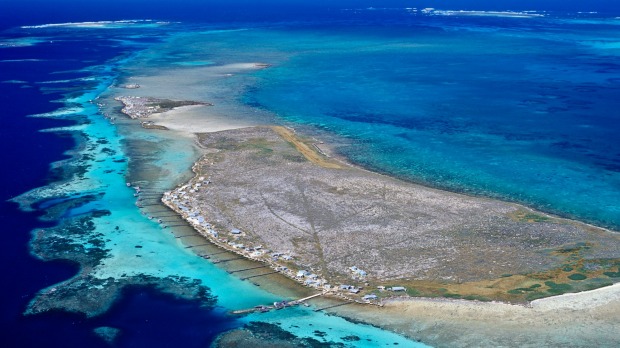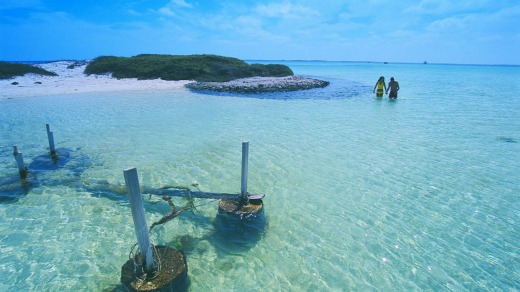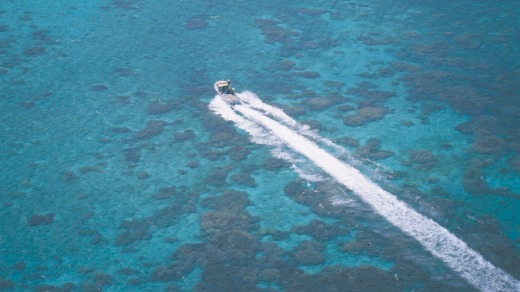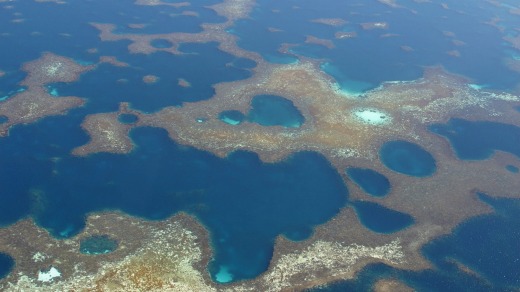
The Morning Reef is dazzlingly pretty. From the air, it's a multicoloured carpet of deep blues, vivid greens and everything in between. In the middle of it, peeking just far enough above the water to count as a landmass, is what looks like a triangle with added bull horns.
That tiny speck is Beacon Island. And it was the epicentre of one of the darkest, but most remarkable, stories in Australian history. It may look calm and unthreatening now, but in 1629, dozens of people were murdered there by a rampaging band of shipwrecked mutineers.
Beacon Island is one of the Houtman-Abrolhos, an archipelago of 122 islands lying about 60 kilometres off the coast of Geraldton in Western Australia. No one lives there permanently, although rock lobster fishermen make temporary bases on many of the islands during the fishing season.

Aside from the fishermen's huts, though, signs of human life pretty much boil down to the series of ships that have come a cropper on the reefs.
The most significant of these was the Batavia, the shiny new flagship of the Dutch East India Company, which was heavily laden with treasure. The destination was the city it was named after – Batavia (now Jakarta) – from where the Dutch East India Company ran its monopoly on the highly lucrative spice trade.
The ship, however, had gone significantly off course – part of a plot by the skipper Araien Jacobsz and undermerchant Jeronimus Cornelisz to isolate the ship from the rest of the fleet and take it over. But then it crashed into Morning Reef before the mutiny could take place.

Some drowned trying to escape the wreck, but most made it to Beacon Island, where it was abundantly clear that the lack of freshwater and food would make survival virtually impossible. Commander Francisco Pelsaert took Jacobsz and other crew to the other islands in a long boat to look for water. They found nothing, so headed to the mainland, and then decided to make the incredibly difficult voyage to Indonesia to get help.
Unfortunately, they didn't tell the rest what they were doing. This left Cornelisz in nominal charge on Beacon Island, and his solution to preserving the supplies left on board the wreck was rather gruesome.
He started by sending groups to other islands where his scouting parties had deceitfully promised there would be water. Crucially, this got rid of the soldiers on board the ship who might challenge the reign of terror he was about to inflict. His fellow would-be mutineers started killing off the rest of the survivors – at first vaguely surreptitiously, and then openly embarking on mass slaughter.

Women were taken as sex slaves, survivors were forced to kill or be killed, children had their throats cut and the mutineers paraded around in the finest clothing rescued from the ship.
Astonishingly, Pelsaert and co made it to Batavia, and came back in the middle of a pitched battle. The soldiers banished to East and West Wallabi Islands had managed to find freshwater and an abundance of tammar wallabies to eat. They were holding out under attack from the mutineers and managed to get to Pelsaert's rescue ship to explain their side of the story first.
Cornelisz and many of the key mutineers were executed on Long Island, while two – Wouter Loos and Jan Pelgrom de Bye – were left on the Australian mainland. They became the first European inhabitants of Australia, and no one knows what happened to them.
Flying over the islands gives a good idea of where things unfolded – the merciless reef that the ship was stricken upon; the considerable distances between the islands that escapees had to navigate clutching only a piece of driftwood; the spot where the wreck was finally found in 1963.
But Geraldton Air Charter's day tour lands on only one island – East Wallabi. This was where the soldiers were initially sent before they waded through the shallows to West Wallabi and found water.
East Wallabi now has a small red dirt airstrip, and an awful lot of untouched white sand beach. It's simultaneously beautiful and desolate – there's an isolated, end of the world feel, with just a small hut on Turtle Bay to let the real world intrude.
The most southerly reefs in the Indian Ocean are a short snorkel offshore, while the walking tracks reveal osprey nests, legions of seabirds and some devastatingly sharp rock cliffs. It'd be these that the Batavia survivors would have had to climb up.
Just off the tracks, however, rustling in the saltbush scrub, are the saviours of the marooned soldiers. The tammar wallabies which give the island its name are still scuttling around, now unthreatened by hungry shipwreck victims. Their ancestors would have had quite the story to pass down through the generations.
Geraldton Air Charter runs day tours to the Houtman-Abrolhos Islands from Geraldton Airport, costing from $260. See geraldtonaircharter.com.au.
Disclosure: The writer was a guest of Tourism Western Australia .
of
See also: The dark secret beneath the Sound of Music house